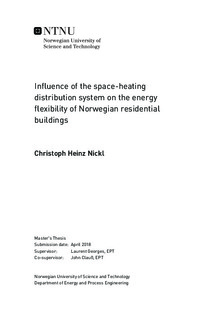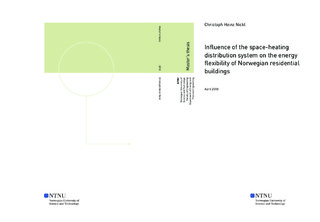| dc.description.abstract | Demand side flexibility gained more and more research interest over the last years, as the generation of renewable power grows and challenges economical operation of power plants as well as grid stability. Several studies were already conducted and showed a large potential in the flexible use of plug loads as well as heating devices. However, there is a vast amount of parameters that influence this potential and need further investigation.
This thesis tries to evaluate the influence of the heating distribution system on the en-ergy flexibility of residential buildings. Different building performance models were created for air heating, radiator heating, and floor heating. The case study building was a nearly zero emission building called Living Lab , located in Trondheim. The energy system consists in each case of a heat pump, domestic hot water and space heating tank, as well as solar thermal collectors and photovoltaic.
The behavior of the different systems was assessed for a rule based control based on a schedule to shift electricity to off-peak hours as well as a price based signal which uses data from the day-head spot market.
For the radiator system the consumption in peak hours was strongly decreased (up to 20%) when domestic hot water and space heating tank set points were included. When only activating the thermal mass, reductions of 10% were found. In contrast, the con-sumption in peak hours did not decrease or even grew for the floor heating case. The air heating cases showed little to no shifting potential.
The total consumption and operational costs increased in each case, most pronounced with the schedule based set point variations for hot water and space heating tank. | |

